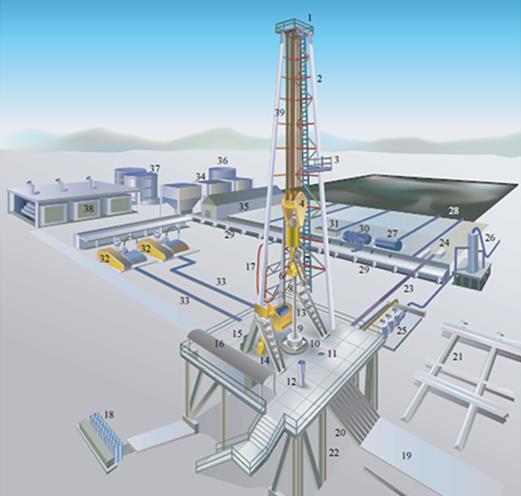Oil and gas drilling, a cornerstone of the global energy economy, involves extracting valuable hydrocarbon resources from beneath the Earth's surface to satisfy growing energy needs worldwide. In this article, we'll delve into the fascinating realm of oil and gas drilling, examining its methods, technologies, challenges, and pivotal role in fueling our contemporary world.

The Significance of Oil and Gas Drilling
Oil and gas drilling is indispensable to both the global economy and modern civilization. This industry serves diverse functions beyond merely meeting daily energy requirements:
Energy Production: Oil and natural gas are versatile energy sources utilized for electricity generation, heating, transportation, and industrial processes. They are essential for sustaining our energy-dependent lifestyles.
Economic Driver: The oil and gas sector significantly contributes to the global economy, generating substantial revenue, creating jobs, and fostering economic development, particularly in regions rich in hydrocarbon reserves.
Infrastructure Development: Drilling operations necessitate the construction of extensive infrastructure, including drilling rigs, pipelines, refineries, and distribution networks, which not only support the industry but also spur growth in surrounding areas.
Global Trade: Hydrocarbon exports and imports are vital for many nations, driving international trade and influencing geopolitical dynamics on a global scale.
Government Revenue: Oil and gas activities generate substantial revenue for governments through taxes, royalties, and licensing fees, which fund public services and infrastructure projects.
Energy Security: Access to domestic hydrocarbon reserves enhances a nation's energy security by reducing reliance on foreign sources, mitigating risks during geopolitical instabilities or supply disruptions.
Chemical Industry: Petrochemicals derived from oil and gas serve as feedstocks for various products, including plastics, chemicals, fertilizers, and pharmaceuticals, supporting numerous industries.
Transportation: Oil and gas power the transportation sector, driving automobiles, trucks, ships, and airplanes, facilitating global commerce, trade, and tourism.
Resource Exploration: Oil and gas drilling is essential for discovering new hydrocarbon deposits, ensuring a stable and sustainable energy supply as existing sources deplete.
Balancing Energy Mix: While transitioning to cleaner energy sources, oil and gas play a crucial role in providing reliable power and backup during intermittent renewable energy generation, contributing to a balanced energy mix.

The Oil and Gas Drilling Process
Oil and gas drilling involves a complex, multi-stage process, encompassing:
Exploration: Geological surveys and seismic research locate potential hydrocarbon-bearing formations, followed by exploratory drilling to confirm their presence.
Well Planning: Engineers and geologists meticulously design the well, considering factors such as depth, geology, and potential challenges.
Drilling: Massive drilling rigs penetrate the Earth's crust using rotary drilling methods, aided by drilling mud to cool the drill bit and carry cuttings to the surface.
Casing and Cementing: Steel casing pipes stabilize the wellbore, and cement seals the space between the casing and the rock, preventing hydrocarbon migration.
Completion: Installation of equipment like wellheads and production tubing allows hydrocarbon extraction from the reservoir.
Production: Hydrocarbons flow from the reservoir through the wellbore to the surface, where they undergo processing, refining, and distribution.
Challenges and Innovations in Oil and Gas Drilling
The oil and gas industry faces various challenges, spurring innovations to address them:
Deepwater Exploration: Innovations like dynamically positioned drillships and subsea production systems enable drilling in challenging deepwater environments.
Unconventional Reservoirs: Advancements in fracking technologies, including horizontal drilling, have unlocked vast unconventional reserves.
Environmental Concerns: Innovations like closed-loop drilling systems and advanced monitoring technologies mitigate environmental impacts.
Safety and Well Control: Advanced blowout preventers and real-time monitoring systems provided by drilling and well control simulators enhance operational safety.

Efficiency and Cost Control: Automation and digital technologies improve operational efficiency and cost-effectiveness.
Energy Transition: The industry explores carbon capture, hydrogen production, and renewable energy investments to adapt to a shifting energy landscape.
Exploration in Extreme Conditions: Specialized equipment facilitates exploration in remote and extreme environments.
Sustainable Practices: Adoption of biofuels, offshore wind, and environmentally friendly methods align with sustainability goals.
Conclusion
Oil and gas drilling remains crucial for meeting global energy needs, driving economic growth, and supporting modern lifestyles. Despite challenges, the industry continues to innovate, striving for efficiency, safety, and environmental sustainability. Understanding the complexities of drilling operations underscores the significance of the energy sector in powering our modern society.






